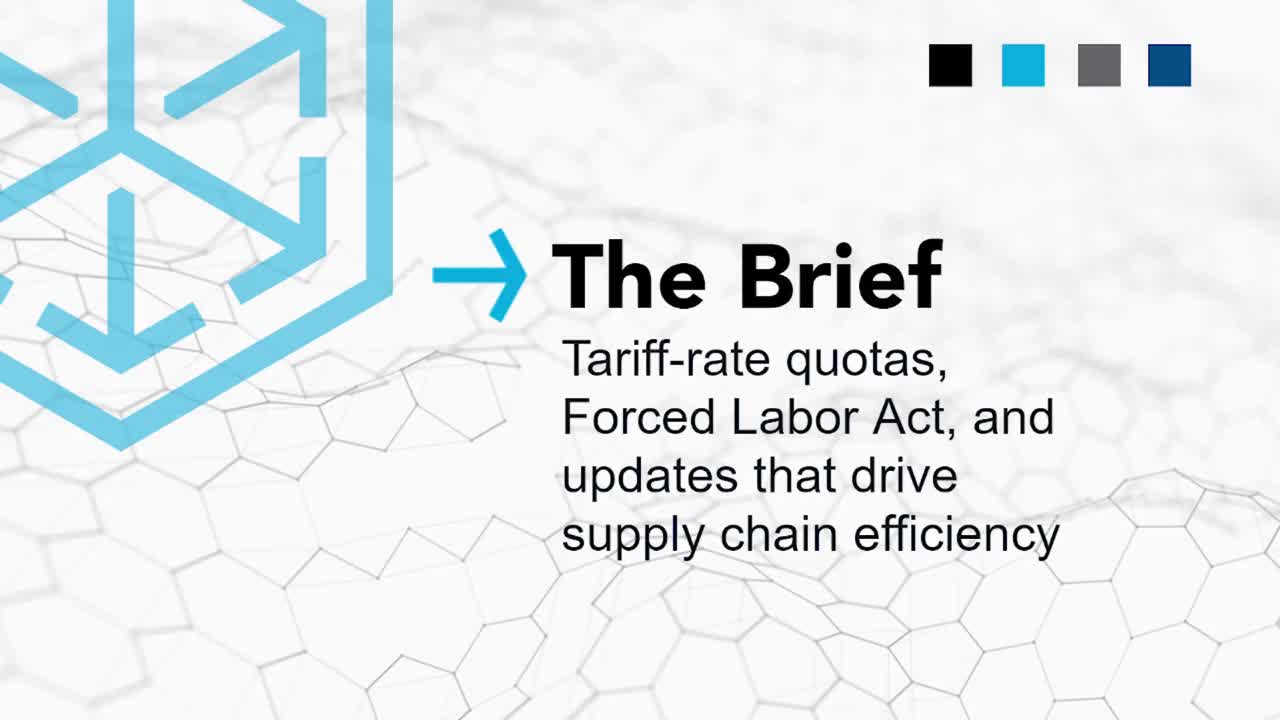Recent Trade & Tariff Perspectives
January 12, 2022 | Anahi Czeszewski Product Development Manager

Significant Legislative Changes Impacting Various Trade Lanes and Looking Ahead at U.S. Trade Policy in 2022
We begin the new year with an abundance of important customs and trade developments largely impacting members of the trade community. From the signing of the Uyghur Forced Labor Prevention Act to the establishment of tariff rate quotas for aluminum and steel imports from the European Union—read on as we review the effects these changes can have on your supply chain and identify the steps you should take to mitigate risk and maximize cost-savings opportunities.
Watch this week's Trade & Tariff Perspective:

Uyghur Forced Labor Prevention Act signed into law
President Biden signed the Uyghur Forced Labor Prevention Act into law on December 23, 2021. As a result, U.S. Customs and Border Protection (CBP) will have the ability to ban importation of all articles produced in whole or in part in the Xinjiang Uyghur Autonomous Region (XUAR), or by entities that source materials from anyone involved in an XUAR forced labor situation—with or without a Withhold Release Order (WRO).
In effect, even goods not imported directly from China can be detained if materials used in the production of the finished imported merchandise in the second country have a tie to XUAR or specific entities and/or commodities associated with forced labor in China.
Under this law, imports of goods from the XUAR will overcome the rebuttable presumption of being made with forced labor, and therefore banned, unless CBP determines that the importer has:
- Fully complied with relevant guidance to be provided by CBP, as well as any regulations issued to implement that guidance
- Completely and substantively responded to all inquiries for information submitted by the Commissioner to ascertain whether the goods were mined, produced, or manufactured wholly or in part with forced labor
- Supplied clear and convincing evidence that the goods were not made wholly or in part by forced labor
The ban will begin 180 days after enactment, which is June 21, 2022. The next five months will be vital, as you review your supply chain and ensure it does not include goods covered under this law.
Tariff-rate quotas established for imports of aluminum and steel articles from the European Union
CBP issued guidance on December 29, 2021, concerning recent presidential proclamations that established a tariff-rate quota (TRQ) process for imports of aluminum and steel articles from the member countries of the European Union (EU). As of January 1, 2022, imported aluminum and steel articles from the EU are subject to a TRQ. Additionally, aluminum and steel derivatives from the EU are no longer subject to Section 232 additional duties.
Associated steel and aluminum products from the EU that are in-quota will enter free of any Section 232 duty. As additional 10 percent (aluminum) and 25 percent (steel) ad valorem Section 232 duty rate will be imposed for applicable imports in excess of the TRQ quantities, stay informed on weekly status updates on TRQs by reviewing commodity status reports.
Automated Commercial Environment (ACE) Secure Data Portal modernization
CBP announced the modernization of the ACE Secure Data Portal, which will occur in phases beginning this year. The ACE Secure Data Portal offers trade users access to an abundance of trade data through reporting, account management, and electronic communication directly with CBP and partner government agencies (PGAs).
The transition will begin with Phase 1, deploying on January 22, 2022. Expect to see various enhancements, including a new login screen, a new home page, and upgraded displays and edit features after this date.
CBP stated users will have access to the legacy ACE Secure Data Portal, which can be accessed through an accompanying link when entering the modernized ACE Secure Data Portal. Be aware the legacy ACE Secure Data Portal, "will be decommissioned once all functionality has been transitioned to the modernized ACE Portal. During this transition period, CBP will continuously synchronize data between both versions."
In future phases, expect to see other enhancements and upgrade including:
- The complete set of links to other applications, available in the references section
- Account creation functionality
- Create/edit functionality for supporting account data
- Document management features
- User management/access tools
The completion of this effort is planned for January 2023.
Tai recaps 2021 and looks forward to 2022
United States Trade Representative (USTR) Katherine Tai reflected on the progress the USTR made in 2021. In a January 1, 2022 video message, she recapped numerous trade policy highlights—including the resolution to the Boeing-Airbus dispute, the success of the U.S.–Mexico–Canada Agreement, and the resolution on the steel and aluminum tariffs with the EU. Tai emphasized the Biden Administration’s commitment to, "rebuild global alliances and partner with allies to prove that democracies can deliver real results for regular people."
Looking ahead, Tai communicated the immediate focus will be on China's performance concerning its obligations under the U.S.–China Trade & Economic Agreement, signed in 2020. Additionally, Tai upheld the Administration's, "strong commitment to multilateral engagement and reinvigorating the forum to inclusive and robust reform," highlighting the continued focus in exploring an Indo-Pacific economic framework.
In closing, Tai said the Administration, "will coordinate with those who share our desire to create a level playing field for all. We will work with our strategic partners to create new tools as well as new rules for fair and competitive trade in the dynamic 21st century." In addition, she noted, "We will stand up for workers' rights all around the world and enhance our efforts to end forced labor in global supply chains."
How can C.H. Robinson help?
Remaining proactively informed in this continuously evolving customs and trade environment can be overwhelming. Fortunately, your supply chain does not need to navigate these changes alone. Connect with one of our trade policy experts to learn more.
Resources
- The Signing of the Uyghur Forced Labor Prevention Act - United States Department of State
- Text - S.65 - 117th Congress (2021-2022): Uyghur Forced Labor Prevention Act | Congress.gov | Library of Congress
- CSMS #50536327 - GUIDANCE: European Union (EU) Section 232 Tariff Rate Quota on Aluminum and Steel Articles and Exempting EU from Derivative Duties (govdelivery.com)
- QB 22-901 2022 First and Second Period Tariff Rate Quota (TRQ) for Aluminum Articles of European Union (EU) Member Countries | U.S. Customs and Border Protection (cbp.gov)
- QB 22-801 2022 First and Second Quarter Tariff Rate Quota (TRQ) for Steel Mill Articles of European Union (EU) Member Countries | U.S. Customs and Border Protection (cbp.gov)
- Commodity Status Reports | U.S. Customs and Border Protection (cbp.gov)
- A Proclamation on Adjusting Imports of Steel into the United States | The White House
- A Proclamation on Adjusting Imports of Aluminum into the United States | The White House
Review recent perspectives
- March 2 | Customs and Trade Policy Developments We’re Following This Month
- February 16 | Transporting goods inside Mexico. Are you complying with Complemento Carta Porte?
- February 2 | Canada to U.S. Shipments: Your Guide to Reducing Import Costs
- January 19 | Importing into the United States from Canada? Here’s What You Need to Know
